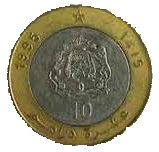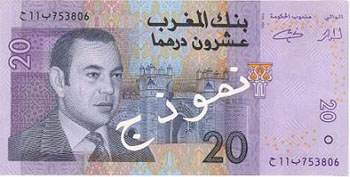|


The dirham (Arabic: درهم, plural: دراهم) is the currency of Morocco. The plural form is pronounced darahim, although in French and English "dirhams" is commonly used. Its ISO 4217 code is "MAD". It is subdivided into 100 santimat (singular: santim, Arabic singular: سنتيم, plural: سنتيما or سنتيمات). The dirham is issued by the Bank Al-Maghrib, the central bank of Morocco. It is also the de facto currency in Western Sahara. While the dirham is a fully convertible currency, export of the local currency is prohibited by law.
History
Before the introduction of a modern coinage in 1882, Morocco issued copper coins denominated in falus, silver coins denominated in dirham & gold coins denominated in benduqi. From 1882, the dirham became a subdivision of the Moroccan rial, with 10 dirham = 1 rial.
The dirham was reintroduced in 1960. It replaced the franc as the major unit of currency but, until 1974, the franc continued to circulate, with 1 dirham = 100 francs. In 1974, the santim replaced the franc.
Coins
In 1960, silver 1 dirham coins were introduced. These were followed by nickel 1 dirham and silver 5 dirham coins in 1965. In 1974, with the introduction of the santim, a new coinage was introduced in denominations of 1, 5, 10, 20 and 50 santimat and 1 dirham. The 1 santim coins were aluminium, the 5 up to 20 santimat were minted in brass, with the highest two denominations in cupro-nickel. Cupro-nickel 5 dirham coins were added in 1980 and changed to a bi-metal coin in 1987. The bi-metal coins bear two year designations for the issue date—1987 in the Gregorian calendar and the 1407 in the Islamic calendar. The 1 santim was only minted until 1987 when new designs were introduced, with a ½ dirham replacing the 50 santimat without changing the size or composition. The new 5 dirham coin was bimetallic, as was the 10 dirham coin introduced in 1995. Cupro-nickel 2 dirham coins were introduced in 2002.
Banknotes
The first notes denominated in dirham were overprints on earlier franc notes, in denominations of 50 dirham (on 5000 francs) and 100 dirham (on 10,000 francs). In 1965, new notes were issued for 5, 10 and 50 dirham. 100 dirham notes were introduced in 1970, followed by 200 dirham notes in 1991 and 20 dirham in 1996. 5 dirham notes were replaced by coins in 1980, with the same happening to 10 dirham notes in 1995.
Popular denominations and usage
Popular denominations are words widely used in Morocco to refer to different values of the currency they are not considered official by the state though. Those include the rial (Arabic pronunciation: ), equivalent to 5 santimat, and the franc [frˤɑnk], equivalent to 1 santim. Usually, when dealing with goods with a value lower than a dirham, it is common to use the rial or santim. For very high priced goods, such as cars, it is normative to refer to the price in santimat. However, rial is used when speaking in Arabic and centime when speaking in French. Though not used by the young generation, the denomination 1000, 2000, ... to 100,000 franc will be used by people who lived during the French colonial period when referring to 10, 20 and 1000 dirham. Likewise, rial is also used for higher value than portions of the dirham, reaching 5000 dhs (100,000 rial). This denomination is used in Arabic speaking context especially in popular milieu such as old medina souks or vegetable markets.
The text on this page has been made available under the Creative Commons Attribution-ShareAlike License and Creative Commons Licenses
|
